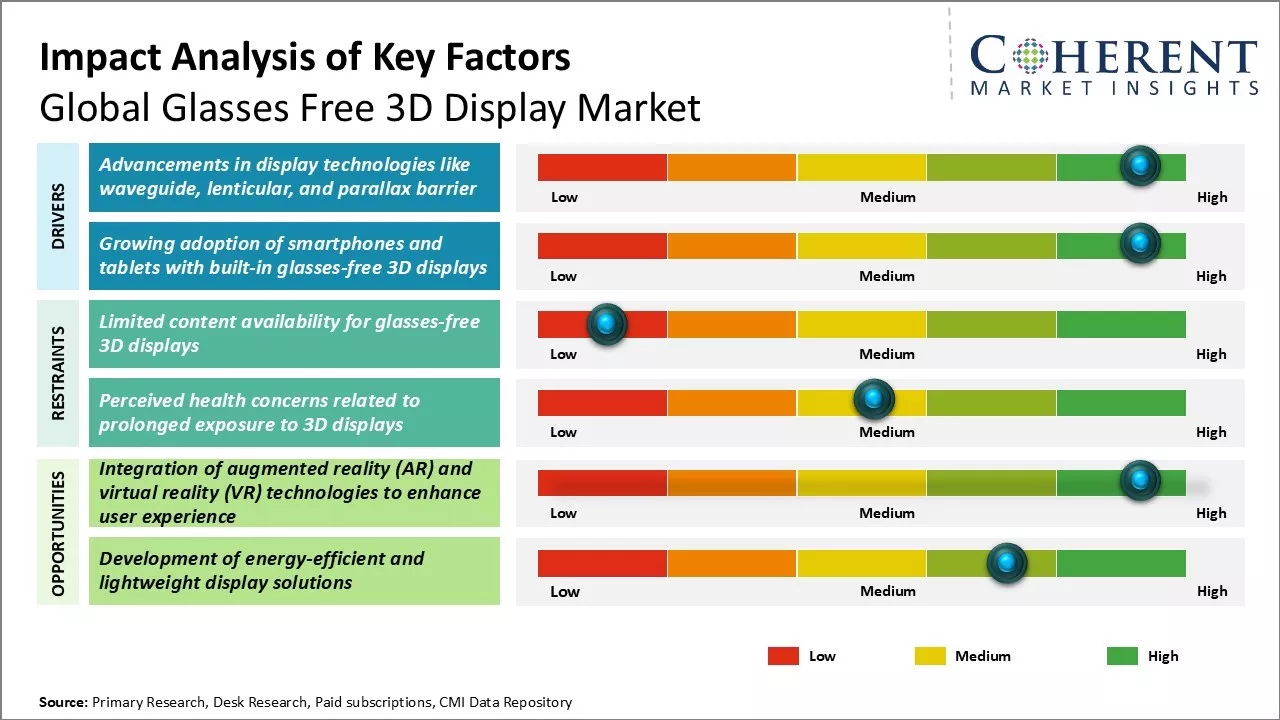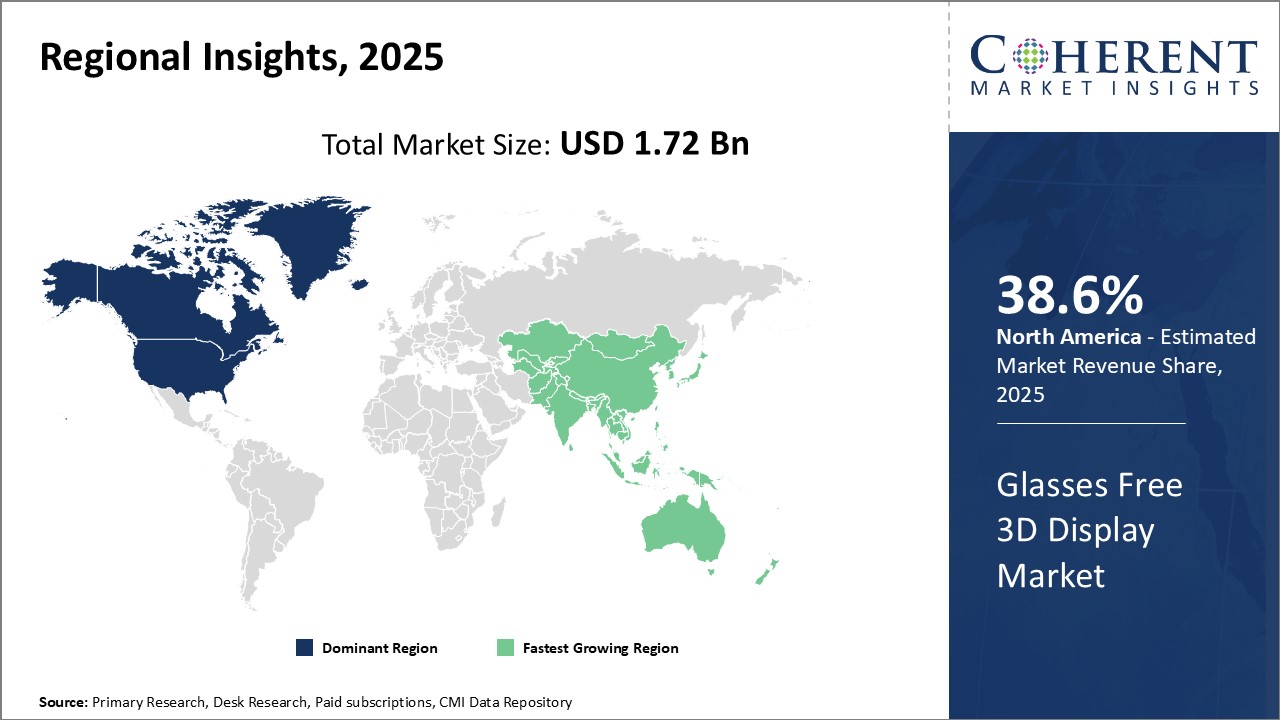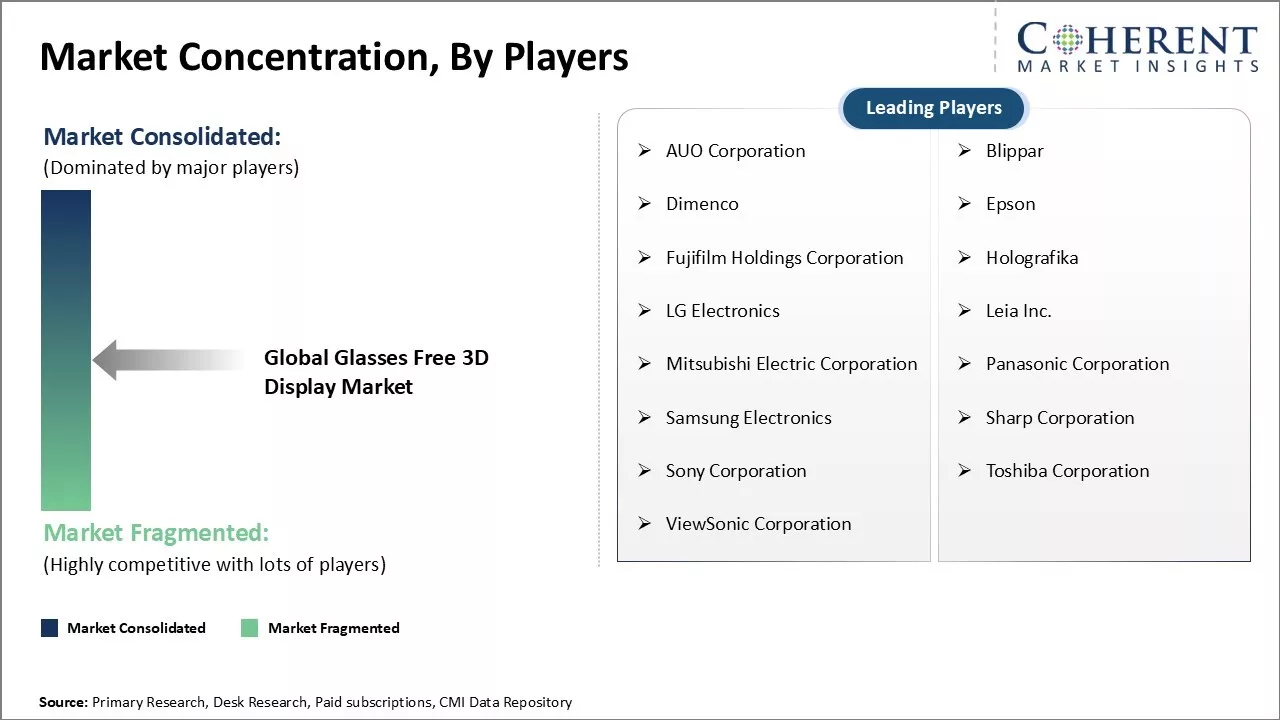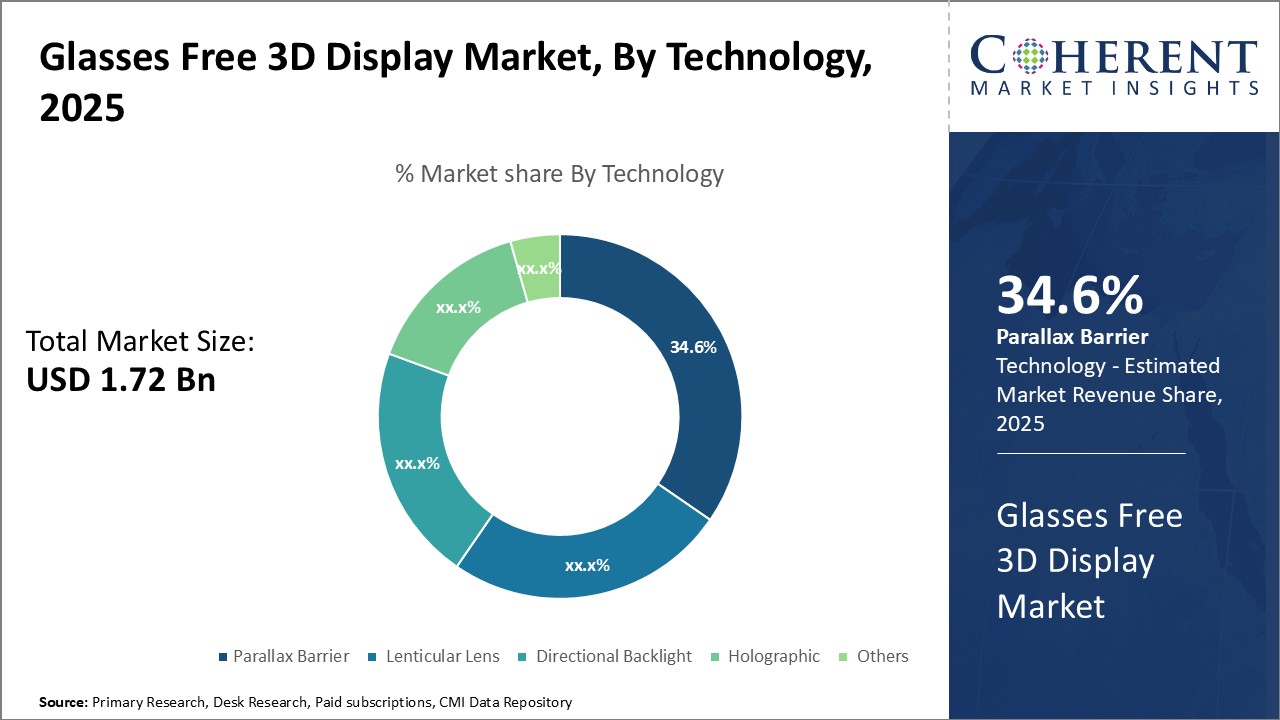Glasses Free 3D Display Market Analysis & Forecast: 2025-2032
Global Glasses Free 3D Display Market Size is estimated to be valued at USD 1.72 Bn in 2025 and is expected to reach USD 5.03 Bn by 2032, exhibiting a compound annual growth rate (CAGR) of 16.6% from 2025 to 2032.

To learn more about this report, Download Free Sample
Key Takeaways
- By Technology, the parallax barrier segment will maintain 34.6% Glasses Free 3D Display Market Share by 2025, due to substantial competition barriers for other glasses-free 3D display technologies.
- By Application, smartphones and tablets are projected to top the list with a 41.8% market share by 2025, as they offer dynamic 3D interaction that allows unobstructed spontaneous face viewing.
- By Vertical, consumer electronics is projected to hold the highest with 53.2% market share by 2025, with the main reason being the adoption and the availability of glasses-free 3D displays in this segment.
- By Region, North America is expected to keep its lead as the dominating market with 38.6% market share in 2025, however, as compared to the Asia-Pacific region which is regarded as the most emerging market globally for glasses-free 3D display technology.
Market Overview
Increasing demand of glasses free viewing experience from end users and technological advancements in the field can drive the glasses free 3D display market growth. The glasses free 3D display market is witnessing strong growth, fueled by rising demand for immersive visual experiences across entertainment, healthcare, and retail sectors. A key example is Meta’s plan to integrate display technology into Ray-Ban smart glasses, highlighting the shift toward wearable, glasses-free 3D solutions. Additionally, rapid technological adoption and growing interest in consumer electronics are positioning Asia-Pacific, particularly China and India, as major growth regions in this evolving market.
Current Events and Its Impact on the Glasses-Free 3D Display Market
|
Event |
Description and Impact |
|
Technological Breakthroughs in Display Hardware |
|
|
Economic Policy Interventions |
|
|
Industry Collaboration & Competition |
|
Uncover macros and micros vetted on 75+ parameters: Get instant access to report
Glasses-Free 3D Display Market Insights, By Technology
In terms of technology, parallax barrier segment is estimated to contribute the highest Glasses Free 3D Display Market Trends share in 2025, owing to significant barriers to entry for competing technologies. Parallax barrier displays utilize a simple optical separation technique that creates a stereoscopic 3D effect without the need for special glasses. This makes parallax barrier the most cost-effective and widely applicable glasses free 3D technology.
Glasses-Free 3D Display Market Insights, By Application
In terms of application, smartphones and tablets segment is estimated to contribute the highest Glasses Free 3D Display Market Forecast share in 2025, as it offers immersive 3D experience. Holding a glasses free 3D smartphone or tablet enables spontaneous 3D viewing and interaction that does not obstruct the face. This makes 3D more accessible and seamlessly blended with normal device usage as compared to other form factors. 3D also improves visual comprehension of maps, documents and other content on small screens.
Glasses-Free 3D Display Market Insights, By Vertical
In terms of vertical, consumer electronics segment is estimated to contribute the highest market share of 53.2% in 2025, owing to the flexibility it offers. Glasses free 3D displays in consumer devices satisfy entertainment and general computing needs while retaining versatility. From smartphones to TVs, these displays integrate 3D into popular product lines versatile enough for work and play. Their seamless multi-function design meets widespread and varied consumer demands. Adapting glasses free 3D to their industrial and clinical setups demands extensive validation and infrastructure changes.
Regional Insights

To learn more about this report, Download Free Sample
North America Glasses-Free 3D Display Market Analysis and Trends
North America is projected to dominate the global glasses-free 3D display market, capturing an estimated 38.6%
share in 2025. This market leadership is supported by the strong presence of technology leaders and advanced display manufacturers, including LG Electronics, Intel, and Texas Instruments. The region’s early adoption of cutting-edge display technologies is driven by robust R&D capabilities, supported by both private sector investments and favorable government funding initiatives.Asia Pacific Glasses-Free 3D Display Market Analysis and Trends
Asia Pacific is anticipated to be the fastest-growing region in the global glasses-free 3D display market throughout the forecast period. Rapid economic growth, increasing digitization, and rising disposable incomes across key economies such as China, India, South Korea, and Japan are fueling demand for advanced display technologies.Dominating Countries in the Glasses-Free 3D Display Market
United States Glasses-Free 3D Display Market Analysis and Trends
The U.S. continues to lead the North American glasses-free 3D display market, backed by its deep-rooted technology infrastructure and a strong presence of pioneering display solution providers. Substantial investments in VR/AR, medical imaging, and interactive digital retail platforms are fueling adoption of glasses-free 3D displays across key application segments. A robust regulatory framework, coupled with consistent support for tech-driven innovation, positions the U.S. at the forefront of global market development.
China Glasses-Free 3D Display Market Analysis and Trends
China is emerging as a key player in the Asia Pacific glasses-free 3D display market, leveraging its world-class manufacturing capabilities and a massive domestic consumer electronics market. The integration of glasses-free 3D technology into smartphones, televisions, and advertising displays is gaining momentum, driven by consumer demand for immersive digital experiences. National policies such as "Made in China 2025" are encouraging technology innovation and self-reliance, fostering rapid commercialization and international competitiveness of locally developed 3D display technologies.
Market Report Scope
Glasses Free 3D Display Market Report Coverage
| Report Coverage | Details | ||
|---|---|---|---|
| Base Year: | 2024 | Market Size in 2025: | USD 1.72 Bn |
| Historical Data for: | 2020 To 2024 | Forecast Period: | 2025 To 2032 |
| Forecast Period 2025 to 2032 CAGR: | 16.6% | 2032 Value Projection: | USD 5.03 Bn |
| Geographies covered: |
|
||
| Segments covered: |
|
||
| Companies covered: |
AUO Corporation, Blippar, Dimenco, Epson, Fujifilm Holdings Corporation, Holografika, LG Electronics, Leia Inc., Mitsubishi Electric Corporation, Panasonic Corporation, Samsung Electronics, Sharp Corporation, Sony Corporation, Toshiba Corporation, and ViewSonic Corporation |
||
| Growth Drivers: |
|
||
| Restraints & Challenges: |
|
||
Uncover macros and micros vetted on 75+ parameters: Get instant access to report
Pricing Analysis
The global Glasses Free 3D Display Market Outlook exhibits a diverse pricing landscape across various device categories, reflecting differences in technology sophistication, brand positioning, and target consumer segments.
- Pricing of Tablets and Smartphones
Starting with the most expensive boundary, equipped with glasses-free 3D displays, Apple’s iPhone 12 Pro and Samsung Galaxy S21 Ultra smartphones are sold at prices ranging approximately from USD 999 to USD 1,599. These Premium devices are digitally enhanced with remarkable features and undergo display refinement which justifies their pricing.
Prices in the mid-range category also accommodate LG Velvet and Xiaomi Mi 11 which are priced together with the other 3D display enabled smartphones, ranging from USD 599 to USD 999. Glasses Free 3D Display Tablets of lower grades like Huawei Mate Pad Pro border ringing in at $799 while premium ones like Apple iPad Pro surpass $2,300. It is notable that the increased priced tablets are indicative of their enlarged screen size and Increased functionalities.
- Laptops and All in One PCS:
There is a flexible range spanning from performance and display capabilities, causing drastic changes in cost across laptops. ASUS ZenBook Pro Duo stands at the higher price border of $2,299 to $3,699, featuring glasses free 3D displays. The pricing caters to professionals who require sophisticated visualization tools.
With models such as the Lenovo Yoga C740 and Acer Swift 3, mid-range laptops are targeted toward the general public due to their more attainable prices ranging from USD 699 to USD 1,499. All-in-one PCs like the Apple iMac and Microsoft Surface Studio 2 featuring advanced 3D displays tend to fall within a broad price spectrum: USD 1,799 and nearly USD 8,800. This showcases their premium market niche and specialized use cases.
- TVs and Monitors:
3D technology integrated into televisions has a cap range of mid-range to ultra-premium pricing tiers. FYI, high-end models like the Samsung QN900A QLED 8K and Sony A90J OLED fall into a price range of USD 2,999 and go all the way up to USD 8,999, underlining paramount display capabilities with large screen sizes.
More budget-friendly options in the USD 649 to USD 1,399 category include mid-range televisions with 3D capabilities, including TCL 6-Series and Hisense H9G. Professional-grade glass-free 3D monitors like the ASUS ProArt and Dell UltraSharp series are offered at a price of USD 3,800 to USD 5,000, designed for specialized content creators and enterprises.
Market Concentration and Competitive Landscape

To learn more about this report, Download Free Sample
Glasses-Free 3D Display Market Growth Driver
Advancements in display technologies like waveguide, lenticular, and parallax barrier
The creation of new innovative display system allows glasses free 3D viewing experience with no compromises on image resolutions and quality. Internal waveguide displays, which refracts and reflect light through layers of material to produce a stereoscopic effect, are becoming more sophisticated for 3D imagery. Leading companies are focusing on compacting highly detailed waveguide designs and flawlessly incorporating them into mobile devices.
Parallax barriers along with lenticular lenses have come a long way from their infancy stages. Improvements in lens designs, tighter grouping of lenslets, and the ability to create barrier patterns at microscopic levels have enhanced 3D imaging quality. Optical constituents have become more robust and less susceptible to breakage over the years. Furthermore, advancements in algorithms now allow for dynamic parallax adjustments to provide wider angles of view with reduced reliance on specific alignment relative to the screen.
All these technical improvements compel manufacturers to aggressively pursue glasses free 3D display as a key differentiator. With resolution capacities of displays matching and exceeding full HD levels, there has been huge demand from consumers especially early technology adopters. The stereoscopic effect also enhances the visual experience of photography, videography, gaming and virtual/augmented reality. Content creators are being encouraged to produce more 3D-optimized media as compatible installed base expands.
Growing smartphone and tablet adoption with build-in glass free 3D displays
Consumer electronics have become indispensable for both personal and professional use in recent times. Smartphones have witnessed huge adoption, replaced other devices, and establishing themselves as the default gateway to the internet, entertainment and information on the go. Tablets, although their growth has tapered, still hold mass market appeal targeted towards professionals, students and general consumers.
These trends in the adoption of mobile technologies underscore the strategies of marketing planners in the area of mobile devices. Leading smartphone and tablet manufacturers are more than eager to flagship new specs and features in order to build brand loyalty and encourage repetitive purchases within shorter upgrade cycles. The 3D displays also fulfill the needs of consuming high-resolution displays beyond non-interactive 2D experiences. There are also wider opportunities for consuming stereoscopic content and AR/VR without needing active attention while on the go.
With improvements, expect a variety of new brands to enter the market with products across all price tiers. The advances made in the android ecosystem are also equally supportive of extensive reach. Advances in the operating system are also more efficient in 3D application streaming. This segment of mobile technology is the best candidate for the introduction of glasses-less 3D displays.
Glasses-Free 3D Display Market Opportunity
Integration of augmented reality (AR) and virtual reality (VR) technologies to enhance user experience
Global Glasses Free 3D Display Market Value can witness opportunities due to integration of augmented reality (AR) and virtual reality (VR) technologies to enhance the overall user experience. Glasses free 3D displays are well-positioned to be compatible with AR applications, where virtual objects can be seamlessly layered on the real-world environment without requiring any additional viewing equipment. VR content can also be rendered on glasses free displays by tracking the user's movements, gestures, and gaze.
The sophisticated optical technologies used in glasses free displays are highly suitable for integrating AR and VR functionalities. As AR/VR adoption grows rapidly in the near future, glasses free displays can leverage these trends and provide an unmatched immersive experience to users without occluding their natural vision. This convergence of technologies has the potential to significantly expand the use cases and market potential of glasses free 3D displays in the near future.
Analyst Viewpoint:
- Technological advancements have made displays thinner, more power efficient and enabled larger screen sizes, and this has led to rising adoption of glasses free 3D displays. As the experience provided by these displays comes close to matching traditional 2D screens, there will be increase in their acceptance as a mainstream technology. Growing demand from users for an immersive entertainment experience without any accessories or eyewear can also drive the market growth. As content providers increase their 3D libraries, it will boost demand for glasses free viewing.
- Limited resolution and small sweetspots can hamper the market growth. Manufacturers will need to overcome these technical challenges to appeal to a broader user base. High initial costs as compared to other display types also impact the consumer decision making.
- North America is expected to dominate the market, owing to strong growth in key countries like U.S., Canada. Regional dominance can be attributed to concentration of major display manufacturers and populace open to new technologies. Meanwhile, developed markets in Asia Pacific will witness faster growth as the technology matures and prices decline over the coming years.
Glasses Free 3D Display Market Key Developments
- In May 2025, Metavista3D showcased a 27-inch pseudo-holographic display at SID Display Week 2025, addressing depth distortions and glare to improve glasses-free 3D visualization quality.
- In April 2025, Sony Electronics expanded its Spatial Reality Display SDK to version 2.5.0, improving OpenXR support and rendering quality for better integration in film production and creative industries.
- In April 2025, PlayNitride and Realfiction unveiled the world’s first MicroLED-based glasses-free 3D display, combining directional pixel technology with MicroLED for enhanced multi-view 3D experiences on a 9-inch screen.
- In April 2025, Samsung launched the Odyssey 3D G9 gaming monitor featuring lenticular lens technology and eye-tracking for glasses-free 3D viewing, targeting immersive gaming experiences with a 27-inch 4K display and 165Hz refresh rate.
- In March 2025, Magnetic 3D introduced its 100-inch holographic glasses-free 3D displays, marking a major commercial milestone for large-format 3D visualization.
Market Segmentation
- By Technology Insights (Revenue, USD Bn, 2025 - 2032)
- Parallax Barrier
- Lenticular Lens
- Directional Backlight
- Holographic
- Others (Volumetric, Light Field, etc.)
- By Application Insights (Revenue, USD Bn, 2025 - 2032)
- Smartphones and Tablets
- Televisions
- Monitors and Laptops
- Digital Signage and Billboards
- Others (Gaming, Medical, Automotive, etc.)
- By Vertical Insights (Revenue, USD Bn, 2025 - 2032)
- Consumer Electronics
- Commercial
- Industrial
- Healthcare
- Others
- Regional Insights (Revenue, USD Bn 2025 - 2032)
- North America
- U.S.
- Canada
- Latin America
- Brazil
- Argentina
- Mexico
- Rest of Latin America
- Europe
- Germany
- U.K.
- Spain
- France
- Italy
- Russia
- Rest of Europe
- Asia Pacific
- China
- India
- Japan
- Australia
- South Korea
- ASEAN
- Rest of Asia Pacific
- Middle East
- GCC Countries
- Israel
- Rest of Middle East
- Africa
- South Africa
- North Africa
- Central Africa
- Key Players Insights
- AUO Corporation
- Blippar
- Dimenco
- Epson
- Fujifilm Holdings Corporation
- Holografika
- LG Electronics
- Leia Inc.
- Mitsubishi Electric Corporation
- Panasonic Corporation
- Samsung Electronics
- Sharp Corporation
- Sony Corporation
- Toshiba Corporation
- ViewSonic Corporation
Sources
Primary Research Interviews
- Industry Experts of Glasses-Free 3D Display Solutions
- Product Managers/Directors from Glasses-Free 3D Device Manufacturing Companies
- Marketing Executives from leading Glasses-Free 3D Display Companies
- Senior Analysts in 3D Display Technology Domain
- Others
Databases
- Bloomberg
- Gartner
- Others
Magazines
- Display Daily
- TechRadar
- Wired Magazine
- Others
Journals
- Journal of Display Technology
- Journal of Society for Information Display
- International Journal of Advanced Computer Technology
- Others
Newspapers
- The Wall Street Journal
- The Economic Times
- Financial Times
- Others
Associations
- Society for Information Display (SID)
- Consumer Technology Association (CTA)
- International 3D Society
- Others
Public Domain Sources
- Others
Proprietary Elements
- CMI Data Analytics Tool
- Proprietary CMI Existing Repository of information for last 8 years
Share
Share
About Author
Ramprasad Bhute is a Senior Research Consultant with over 6 years of experience in market research and business consulting. He manages consulting and market research projects centered on go-to-market strategy, opportunity analysis, competitive landscape, and market size estimation and forecasting. He also advises clients on identifying and targeting absolute opportunities to penetrate untapped markets.
Missing comfort of reading report in your local language? Find your preferred language :
Transform your Strategy with Exclusive Trending Reports :
Frequently Asked Questions
EXISTING CLIENTELE
Joining thousands of companies around the world committed to making the Excellent Business Solutions.
View All Our Clients

